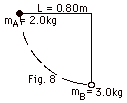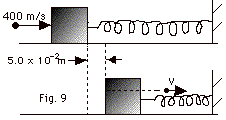|
Review - Center of Mass, Momentum,
and Collisions
|
|
|
1.
|
A tennis player receives a shot with
the ball (0.060 kg) traveling horizontally at 50 m/s, and
returns the shot with the ball traveling horizontally as 40
m/s in the opposite direction. What is the impulse delivered
to the ball by the racket?
|
|
|
2.
|
Four particles are distributed in the
X-Y plane as shown in Fig. 1 below. Find the coordinates (XCM,
YCM) of the particles. The particles
are on the corners of a
2.0-m square.

|
|
|
3.
|
A 1500-kg automobile travels eastward
at a speed of 8.0 m/s. It makes a 90o turn to the
north in a time of 3.0 s and continues with the same speed.
Find (a) the impulse delivered to the car as a result of the
turn (b) the average force exerted on the car during the turn
and (c) the average force of the car on the road during the
turn.
|
|
|
4.
|
Six particles with equal mass m are arranged
to correspond to the six corners of a regular hexagon, as
shown in Fig. 2 below. Locate the center of mass of the system.

|
|
|
5.
|
Object A of mass 1.0 kg travels with
a speed of 4.0 m/s, while object B of mass 2.0 kg travels
with a speed of 2.00 m/s. Compare (a) the magnitude of their
momenta and (b) their kinetic energies.
|
|
|
6.
|
Two skaters stand in the center of a
circular rink of frictionless ice. When the skaters push on
one another, they move apart along the same straight line.
If the skater of mass m1 = 50 kg reaches the edge
of the rink after 12 s and the other skater reaches the opposite
edge of the rink in 18 s, what is the mass m2 of
the second skater?
|
|
|
7.
|
A 0.050-kg block moving to the right
with a speed of 0.20 m/s collides with a 0.10-kg block moving
to the left with a speed of 0.04 m/s. After the collision
the blocks stick together and go off with a common velocity
vf. Find vf.
|
|
|
8.
|
For a number of point masses, the x-component
of the center of mass is:

and for an extended object,

An object of mass M is in the shape of a right triangle with
altitude a and base b as shown in Fig. 3 below. Find (a) the
area of the triangle, (b) the mass per unit area σ.
(c) the area dA of the element in Fig. 3a of height dy and
width dx, (d) the mass dm of this element, (e) x dm,
(f) the equation for the line which is the hypotenuse of the
triangle, (g) an expression for x dm in terms of x and constants,
(h) the integral expression for XCM with limits
and XCM. Repeat using Fig. 3b for YCM.

|
|
|
9.
|
Find the position of the center of mass
of five equal-mass particles located at the five corners of
a square based right pyramid with sides of length L and height
h.
|
|
|
10.
|
A 75-kg man is standing in a 225-kg barge
and is originally 10 m from a pier on a still lake. The man
walks towards the pier a distance of 2.0 m relative to the
barge, and then stops. Assuming the barge can move through
the water without resistance, how far is the man now from
the pier?
|
|
|
11.
|
After a nucleus decays, the products
of the decay move off in opposite directions with equal and
opposite momenta. What is the initial momentum of the nucleus?
|
|
|
12.
|
Object A with mass mA = 3.0
kg moving in the +x-direction with a velocity of
1.0 m/s collides with object B with mB = 2.0 kg
moving in the +y-direction with velocity of 2.0 m/s. After
the collision, the blocks stick together. Find the magnitude
and direction of the final velocity vf.
|
|
|
13.
|
Seven steel blocks of equal mass m rest
on a frictionless table. If one of the blocks is given an
initial velocity vo and it collides with the other
six, a block at the other end always goes off with vo
(Fig. 4a below). The collision in Fig. 4b below never happens.
Suggest a reason why the collision in Fig. 4b never happens.

|
|
|
14.
|
This is a one-dimensional problem. A
1.0-kg block moving with a velocity of
2.0 m/s to the right collides elastically with a second block
that is initially at rest. Find the velocities of the two
blocks after the collision if the mass of the second block
is (a) 1.0 kg, (b) 1,000 kg, (c) 0.001 kg.
|
|
|
15.
|
This is a one-dimensional problem. A
4.0-kg block moving with a velocity of
2.0 m/s to the right collides elastically with a 1.0-kg block
moving with a velocity of 3.0 m/s to the left. Find the velocity
of the two blocks after the collision.
|
|
|
16.
|
Describe the collision of the blocks
in Problem 15 in the center of mass coordinate system.
|
|
|
17.
|
A disk with a mass m1 = 10
kg traveling along a smooth surface with a velocity of 24
m/s along the +X-axis collides with a stationary second disk
of mass m2 = 20 kg. After the collision, the first
disk moves along the + Y-axis with a velocity of 10 m/s. What
was the velocity (direction and magnitude) of the second disk
after the collision?
|
|
|
18.
|
A disk with a mass m1 = 2.0
kg traveling along a smooth surface with a velocity of 39
m/s along the +X-axis collides with a stationary second disk
of mass m2 = 8.0 kg. After the collision the second
disk moves with a velocity of 10 m/s at an angle of 37o
above the X-axis. (a) Find the velocity (magnitude and direction)
of the first disk after the collision. (b) Was this an elastic
collision?
|
|
|
19.
|
A proton moving with a velocity of v1i
i collides elastically with another proton initially
at rest. If both protons have the same speed (v1f
= v2f) after the collision, find (a) the speed
of each proton after the collision in terms of v1i
and (b) the direction of the velocity vectors after the collision.
|
|
|
20.
|
A 2.0-kg Block A slides down a frictionless
chute (Fig. 5 below) and then strikes a stationary 9.2-kg
block B on a horizontal table. (a) What is the velocity of
A at the bottom of the chute? (b) If A sticks to B after the
collision, what is their common velocity immediately after
the collision? (c) If the frictional force between the blocks
and the table is 2.8 N, how far do they slide before coming
to rest? Take g = 9.8 m/s2.

|
|
|
21.
|
A mass m hangs by a string of length
L. A second identical mass is sliding along a frictionless
surface with velocity vo (Fig. 6 below). (a)
If the two masses have an elastic collision, how high will
the first mass rise? (b) If the two masses have a totally
inelastic collision, how high will the masses rise?

|
|
|
22.
|
A horizontal force of 0.80 N is required
to move m2 = 5.0 kg of Fig. 7 below across the
surface with a constant velocity. With the block initially
at rest, a 0.020-kg bullet m1 fired horizontally
into the block causes the block (with bullet inside) to slide
1.5 m before coming to rest again. Find the speed vo1
of the bullet.

|
|
|
23.
|
A 2.0-kg steel ball A and a 3.0-kg steel
ball B coated with putty are suspended by strings of length
L = 0.80 m. When ball A is released from the position shown
in Fig. 8 below, it strikes ball B. After the collision, the
balls move with a common velocity. Find (a) the kinetic energy
of ball A just before the collision, (b) the velocity of ball
A just before the collision, (c) the common velocity of the
balls immediately after the collision, and (d) the height
to which the two balls rise after the collision. Take g =
10 m/s2.

|
|
|
24.
|
Now imagine the putty of ball B in #23
is removed and there is an elastic collision between the two
balls. Find (a) the kinetic energy of ball A just before the
collision, (b) the velocity of ball A just before the collision,
(c) the velocities of A and B immediately after the collision,
and (d) the heights to which ball (i) B and (ii) A rise after
the collision.
|
|
|
25.
|
A 5.0 x 10-3-kg bullet moving
with an initial speed of 400 m/s is fired into and passes
through a 1.0-kg block, as shown in Fig. 9 below. The block
initially at rest on a frictionless, horizontal surface is
connected to a spring of force constant 900 N/m. If the block
moves a distance of 5.0 x 10-2 m to the right after
impact and comes to rest momentarily, find (a) the speed at
which the bullet emerges from the block and (b) the energy
lost in the block.

|
|
|
26.
|
A number of years ago, The New Yorker
gave the following quote, "Every time you drop a pin,
the earth moves upward slightly." The comment after that
was, "Butterfingers." Please explain the quote.
|
|